Medscape CME Activity
Medscape, LLC is pleased to provide online continuing medical education (CME) for selected journal articles, allowing clinicians the opportunity to earn CME credit. In support of improving patient care, these activities have been planned and implemented by Medscape, LLC and Emerging Infectious Diseases. Medscape, LLC is jointly accredited by the Accreditation Council for Continuing Medical Education (ACCME), the Accreditation Council for Pharmacy Education (ACPE), and the American Nurses Credentialing Center (ANCC), to provide continuing education for the healthcare team.
CME credit is available for one year after publication.
Volume 17—2011
Volume 17, Number 12—December 2011

A retrospective study conducted in France indicated that a large proportion of patients injured by potentially rabid animals while in North Africa did not seek pretravel advice, and some had not received proper rabies postexposure prophylaxis while in North Africa. As a result, imported human rabies cases are still being reported, and the need for postexposure prophylaxis after exposure in North Africa is not declining. Tourists are generally unaware of the danger of importing potentially rabid animals and of the rules governing the movement of pets. In France, for example, rabid dogs have frequently been imported from Morocco to France through Spain. This situation imposes heavy social and economic costs and impedes rabies control in Europe. Rabies surveillance and control should therefore be reinforced in North Africa, and travelers to North Africa should receive appropriate information about rabies risk and prevention.
| EID | Gautret P, Ribadeau-Dumas F, Parola P, Brouqui P, Bourhy H. Risk for Rabies Importation from North Africa. Emerg Infect Dis. 2011;17(12):2187-2193. https://doi.org/10.3201/eid1712.110300 |
|---|---|
| AMA | Gautret P, Ribadeau-Dumas F, Parola P, et al. Risk for Rabies Importation from North Africa. Emerging Infectious Diseases. 2011;17(12):2187-2193. doi:10.3201/eid1712.110300. |
| APA | Gautret, P., Ribadeau-Dumas, F., Parola, P., Brouqui, P., & Bourhy, H. (2011). Risk for Rabies Importation from North Africa. Emerging Infectious Diseases, 17(12), 2187-2193. https://doi.org/10.3201/eid1712.110300. |
To assess the global incidence and clinical effects of human trichinellosis, we analyzed outbreak report data for 1986–2009. Searches of 6 international databases yielded 494 reports. After applying strict criteria for relevance and reliability, we selected 261 reports for data extraction. From 1986 through 2009, there were 65,818 cases and 42 deaths reported from 41 countries. The World Health Organization European Region accounted for 87% of cases; 50% of those occurred in Romania, mainly during 1990–1999. Incidence in the region ranged from 1.1 to 8.5 cases per 100,000 population. Trichinellosis affected primarily adults (median age 33.1 years) and about equally affected men (51%) and women. Major clinical effects, according to 5,377 well-described cases, were myalgia, diarrhea, fever, facial edema, and headaches. Pork was the major source of infection; wild game sources were also frequently reported. These data will be valuable for estimating the illness worldwide.
| EID | Murrell KD, Pozio E. Worldwide Occurrence and Impact of Human Trichinellosis, 1986–2009. Emerg Infect Dis. 2011;17(12):2194-2202. https://doi.org/10.3201/eid1712.110896 |
|---|---|
| AMA | Murrell KD, Pozio E. Worldwide Occurrence and Impact of Human Trichinellosis, 1986–2009. Emerging Infectious Diseases. 2011;17(12):2194-2202. doi:10.3201/eid1712.110896. |
| APA | Murrell, K. D., & Pozio, E. (2011). Worldwide Occurrence and Impact of Human Trichinellosis, 1986–2009. Emerging Infectious Diseases, 17(12), 2194-2202. https://doi.org/10.3201/eid1712.110896. |
Volume 17, Number 11—November 2011
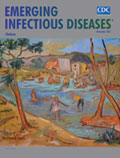
To clarify the cause of deaths associated with pandemic (H1N1) 2009 among children in Japan, we retrospectively studied 41 patients <20 years of age who had died of pandemic (H1N1) 2009 through March 31, 2010. Data were collected through interviews with attending physicians and chart reviews. Median age of patients was 59 months; one third had a preexisting condition. Cause of death was categorized as unexpected cardiopulmonary arrest for 15 patients, encephalopathy for 15, and respiratory failure for 6. Preexisting respiratory or neurologic disorders were more frequent in patients with respiratory failure and less frequent in patients with unexpected cardiopulmonary arrest. The leading causes of death among children with pandemic (H1N1) 2009 in Japan were encephalopathy and unexpected cardiopulmonary arrest. Deaths associated with respiratory failure were infrequent and occurred primarily among children with preexisting conditions. Vaccine use and public education are necessary for reducing influenza-associated illness and death.
| EID | Okumura A, Nakagawa S, Kawashima H, Muguruma T, Saito O, Fujimoto J, et al. Deaths Associated with Pandemic (H1N1) 2009 among Children, Japan, 2009–2010. Emerg Infect Dis. 2011;17(11):1993-2000. https://doi.org/10.3201/eid1711.110649 |
|---|---|
| AMA | Okumura A, Nakagawa S, Kawashima H, et al. Deaths Associated with Pandemic (H1N1) 2009 among Children, Japan, 2009–2010. Emerging Infectious Diseases. 2011;17(11):1993-2000. doi:10.3201/eid1711.110649. |
| APA | Okumura, A., Nakagawa, S., Kawashima, H., Muguruma, T., Saito, O., Fujimoto, J....Morishima, T. (2011). Deaths Associated with Pandemic (H1N1) 2009 among Children, Japan, 2009–2010. Emerging Infectious Diseases, 17(11), 1993-2000. https://doi.org/10.3201/eid1711.110649. |
Escherichia coli clonal group A (CGA) was first reported in 2001 as an emerging multidrug-resistant extraintestinal pathogen. Because CGA has considerable implications for public health, we examined the trends of its global distribution, clinical associations, and temporal prevalence for the years 1998–2007. We characterized 2,210 E. coli extraintestinal clinical isolates from 32 centers on 6 continents by CGA status for comparison with trimethoprim/sulfamethoxazole (TMP/SMZ) phenotype, specimen type, inpatient/outpatient source, and adult/child host; we adjusted for clustering by center. CGA prevalence varied greatly by center and continent, was strongly associated with TMP/SMZ resistance but not with other epidemiologic variables, and exhibited no temporal prevalence trend. Our findings indicate that CGA is a prominent, primarily TMP/SMZ-resistant extraintestinal pathogen concentrated within the Western world, with considerable pathogenic versatility. The stable prevalence of CGA over time suggests full emergence by the late 1990s, followed by variable endemicity worldwide as an antimicrobial drug–resistant public health threat.
| EID | Johnson JR, Menard ME, Lauderdale T, Kosmidis C, Gordon D, Collignon P, et al. Global Distribution and Epidemiologic Associations of Escherichia coli Clonal Group A, 1998–2007. Emerg Infect Dis. 2011;17(11):2001-2009. https://doi.org/10.3201/eid1711.110488 |
|---|---|
| AMA | Johnson JR, Menard ME, Lauderdale T, et al. Global Distribution and Epidemiologic Associations of Escherichia coli Clonal Group A, 1998–2007. Emerging Infectious Diseases. 2011;17(11):2001-2009. doi:10.3201/eid1711.110488. |
| APA | Johnson, J. R., Menard, M. E., Lauderdale, T., Kosmidis, C., Gordon, D., Collignon, P....Kuskowski, M. A. (2011). Global Distribution and Epidemiologic Associations of Escherichia coli Clonal Group A, 1998–2007. Emerging Infectious Diseases, 17(11), 2001-2009. https://doi.org/10.3201/eid1711.110488. |
Frequent zoonotic transmission of hepatitis E virus (HEV) has been suspected, but data supporting the animal origin of autochthonous cases are still sparse. We assessed the genetic identity of HEV strains found in humans and swine during an 18-month period in France. HEV sequences identified in patients with autochthonous hepatitis E infection (n = 106) were compared with sequences amplified from swine livers collected in slaughterhouses (n = 43). Phylogenetic analysis showed the same proportions of subtypes 3f (73.8%), 3c (13.4%), and 3e (4.7%) in human and swine populations. Furthermore, similarity of >99% was found between HEV sequences of human and swine origins. These results indicate that consumption of some pork products, such as raw liver, is a major source of exposure for autochthonous HEV infection.
| EID | Bouquet J, Tessé S, Lunazzi A, Eloit M, Rose N, Nicand E, et al. Close Similarity between Sequences of Hepatitis E Virus Recovered from Humans and Swine, France, 2008−2009. Emerg Infect Dis. 2011;17(11):2018-2025. https://doi.org/10.3201/eid1711.110616 |
|---|---|
| AMA | Bouquet J, Tessé S, Lunazzi A, et al. Close Similarity between Sequences of Hepatitis E Virus Recovered from Humans and Swine, France, 2008−2009. Emerging Infectious Diseases. 2011;17(11):2018-2025. doi:10.3201/eid1711.110616. |
| APA | Bouquet, J., Tessé, S., Lunazzi, A., Eloit, M., Rose, N., Nicand, E....Pavio, N. (2011). Close Similarity between Sequences of Hepatitis E Virus Recovered from Humans and Swine, France, 2008−2009. Emerging Infectious Diseases, 17(11), 2018-2025. https://doi.org/10.3201/eid1711.110616. |
Volume 17, Number 10—October 2011
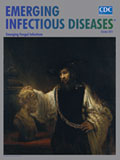
The prevalence and spread of azole resistance in clinical Aspergillus fumigatus isolates in the Netherlands are currently unknown. Therefore, we performed a prospective nationwide multicenter surveillance study to determine the effects of resistance on patient management strategies and public health. From June 2007 through January 2009, all clinical Aspergillus spp. isolates were screened for itraconazole resistance. In total, 2,062 isolates from 1,385 patients were screened; the prevalence of itraconazole resistance in A. fumigatus in our patient cohort was 5.3% (range 0.8%–9.5%). Patients with a hematologic or oncologic disease were more likely to harbor an azole-resistant isolate than were other patient groups (p<0.05). Most patients (64.0%) from whom a resistant isolate was identified were azole naive, and the case-fatality rate of patients with azole-resistant invasive aspergillosis was 88.0%. Our study found that multiazole resistance in A. fumigatus is widespread in the Netherlands and is associated with a high death rate for patients with invasive aspergillosis.
| EID | van der Linden J, Snelders E, Kampinga GA, Rijnders BJ, Mattsson E, Debets-Ossenkopp YJ, et al. Clinical Implications of Azole Resistance in Aspergillus fumigatus, the Netherlands, 2007–2009. Emerg Infect Dis. 2011;17(10):1846-1854. https://doi.org/10.3201/eid1710.110226 |
|---|---|
| AMA | van der Linden J, Snelders E, Kampinga GA, et al. Clinical Implications of Azole Resistance in Aspergillus fumigatus, the Netherlands, 2007–2009. Emerging Infectious Diseases. 2011;17(10):1846-1854. doi:10.3201/eid1710.110226. |
| APA | van der Linden, J., Snelders, E., Kampinga, G. A., Rijnders, B. J., Mattsson, E., Debets-Ossenkopp, Y. J....Verweij, P. E. (2011). Clinical Implications of Azole Resistance in Aspergillus fumigatus, the Netherlands, 2007–2009. Emerging Infectious Diseases, 17(10), 1846-1854. https://doi.org/10.3201/eid1710.110226. |
Recent reports describe increasing incidence of non-Aspergillus mold infections in hematopoietic cell transplant (HCT) and solid organ transplant (SOT) recipients. To investigate the epidemiology of infections with Mucorales, Fusarium spp., and Scedosporium spp. molds, we analyzed data from the Transplant-Associated Infection Surveillance Network, 23 transplant centers that conducted prospective surveillance for invasive fungal infections during 2001–2006. We identified 169 infections (105 Mucorales, 37 Fusarium spp., and 27 Scedosporium spp.) in 169 patients; 124 (73.4%) were in HCT recipients, and 45 (26.6%) were in SOT recipients. The crude 90-day mortality rate was 56.6%. The 12-month mucormycosis cumulative incidence was 0.29% for HCT and 0.07% for SOT. Mucormycosis incidence among HCT recipients varied widely, from 0.08% to 0.69%, with higher incidence in cohorts receiving transplants during 2003 and 2004. Non-Aspergillus mold infections continue to be associated with high mortality rates. The incidence of mucormycosis in HCT recipients increased substantially during the surveillance period.
| EID | Park BJ, Pappas PG, Wannemuehler KA, Alexander BD, Anaissie EJ, Andes DR, et al. Invasive Non-Aspergillus Mold Infections in Transplant Recipients, United States, 2001–2006. Emerg Infect Dis. 2011;17(10):1855-1864. https://doi.org/10.3201/eid1710.110087 |
|---|---|
| AMA | Park BJ, Pappas PG, Wannemuehler KA, et al. Invasive Non-Aspergillus Mold Infections in Transplant Recipients, United States, 2001–2006. Emerging Infectious Diseases. 2011;17(10):1855-1864. doi:10.3201/eid1710.110087. |
| APA | Park, B. J., Pappas, P. G., Wannemuehler, K. A., Alexander, B. D., Anaissie, E. J., Andes, D. R....Kontoyiannis, D. P. (2011). Invasive Non-Aspergillus Mold Infections in Transplant Recipients, United States, 2001–2006. Emerging Infectious Diseases, 17(10), 1855-1864. https://doi.org/10.3201/eid1710.110087. |
Volume 17, Number 9—September 2011

Quantifying how close hospitals came to exhausting capacity during the outbreak of pandemic influenza A (H1N1) 2009 can help the health care system plan for more virulent pandemics. This ecologic analysis used emergency department (ED) and inpatient data from 34 US children's hospitals. For the 11-week pandemic (H1N1) 2009 period during fall 2009, inpatient occupancy reached 95%, which was lower than the 101% occupancy during the 2008–09 seasonal influenza period. Fewer than 1 additional admission per 10 inpatient beds would have caused hospitals to reach 100% occupancy. Using parameters based on historical precedent, we built 5 models projecting inpatient occupancy, varying the ED visit numbers and admission rate for influenza-related ED visits. The 5 scenarios projected median occupancy as high as 132% of capacity. The pandemic did not exhaust inpatient bed capacity, but a more virulent pandemic has the potential to push children’s hospitals past their maximum inpatient capacity.
| EID | Sills MR, Hall M, Fieldston ES, Hain PD, Simon HK, Brogan TV, et al. Inpatient Capacity at Children’s Hospitals during Pandemic (H1N1) 2009 Outbreak, United States. Emerg Infect Dis. 2011;17(9):1685-1681. https://doi.org/10.3201/eid1709.101950 |
|---|---|
| AMA | Sills MR, Hall M, Fieldston ES, et al. Inpatient Capacity at Children’s Hospitals during Pandemic (H1N1) 2009 Outbreak, United States. Emerging Infectious Diseases. 2011;17(9):1685-1681. doi:10.3201/eid1709.101950. |
| APA | Sills, M. R., Hall, M., Fieldston, E. S., Hain, P. D., Simon, H. K., Brogan, T. V....Shah, S. S. (2011). Inpatient Capacity at Children’s Hospitals during Pandemic (H1N1) 2009 Outbreak, United States. Emerging Infectious Diseases, 17(9), 1685-1681. https://doi.org/10.3201/eid1709.101950. |
Members of the Mycobacterium chelonae-abscessus complex represent Mycobacterium species that cause invasive infections in immunocompetent and immunocompromised hosts. We report the detection of a new pathogen that had been misidentified as M. chelonae with an atypical antimicrobial drug susceptibility profile. The discovery prompted a multicenter investigation of 26 patients. Almost all patients were from the northeastern United States, and most had underlying sinus or pulmonary disease. Infected patients had clinical features similar to those with M. abscessus infections. Taxonomically, the new pathogen shared molecular identity with members of the M. chelonae-abscessus complex. Multilocus DNA target sequencing, DNA-DNA hybridization, and deep multilocus sequencing (43 full-length genes) support a new taxon for these microorganisms. Because most isolates originated in Pennsylvania, we propose the name M. franklinii sp. nov. This investigation underscores the need for accurate identification of Mycobacterium spp. to detect new pathogens implicated in human disease.
| EID | Simmon KE, Brown-Elliott BA, Ridge PG, Durtschi JD, Mann LB, Slechta ES, et al. Mycobacterium chelonae-abscessus Complex Associated with Sinopulmonary Disease, Northeastern USA. Emerg Infect Dis. 2011;17(9):1692-1700. https://doi.org/10.3201/eid1709.101667 |
|---|---|
| AMA | Simmon KE, Brown-Elliott BA, Ridge PG, et al. Mycobacterium chelonae-abscessus Complex Associated with Sinopulmonary Disease, Northeastern USA. Emerging Infectious Diseases. 2011;17(9):1692-1700. doi:10.3201/eid1709.101667. |
| APA | Simmon, K. E., Brown-Elliott, B. A., Ridge, P. G., Durtschi, J. D., Mann, L. B., Slechta, E. S....Petti, C. A. (2011). Mycobacterium chelonae-abscessus Complex Associated with Sinopulmonary Disease, Northeastern USA. Emerging Infectious Diseases, 17(9), 1692-1700. https://doi.org/10.3201/eid1709.101667. |
Volume 17, Number 8—August 2011
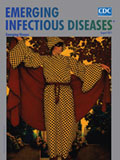
Human adenovirus (HAdV) serotype 14 is rarely identified. However, an emerging variant, termed HAdV-14p1, recently has been described in the United States in association with outbreaks of acute respiratory disease with high rates of illness and death. We retrospectively analyzed specimens confirmed positive for HAdV by immunofluorescence, virus culture, or real-time PCR during July 1, 2009–July 31, 2010, and describe 9 cases of HAdV-14p1 infection with characteristic mutations in the fiber and E1A genes that are phylogenetically indistinguishable from the viruses previously detected in the United States. Three patients died; 2 were immunocompromised, and 1 was an immunocompetent adult. We propose that surveillance should be increased for HAdV-14p1 and recommend that this virus be considered in the differential diagnosis of sudden-onset acute respiratory disease, particularly fatal infections, for which an etiology is not clear.
| EID | Carr MJ, Kajon AE, Lu X, Dunford L, O’Reilly P, Holder P, et al. Deaths Associated with Human Adenovirus-14p1 Infections, Europe, 2009–2010. Emerg Infect Dis. 2011;17(8):1402-1408. https://doi.org/10.3201/eid1708.101760 |
|---|---|
| AMA | Carr MJ, Kajon AE, Lu X, et al. Deaths Associated with Human Adenovirus-14p1 Infections, Europe, 2009–2010. Emerging Infectious Diseases. 2011;17(8):1402-1408. doi:10.3201/eid1708.101760. |
| APA | Carr, M. J., Kajon, A. E., Lu, X., Dunford, L., O’Reilly, P., Holder, P....Hall, W. W. (2011). Deaths Associated with Human Adenovirus-14p1 Infections, Europe, 2009–2010. Emerging Infectious Diseases, 17(8), 1402-1408. https://doi.org/10.3201/eid1708.101760. |
A total of 828 community-dwelling adults were studied during the course of the pandemic (H1N1) 2009 outbreak in Singapore during June–September 2009. Baseline blood samples were obtained before the outbreak, and 2 additional samples were obtained during follow-up. Seroconversion was defined as a >4-fold increase in antibody titers to pandemic (H1N1) 2009, determined by using hemagglutination inhibition. Men were more likely than women to seroconvert (mean adjusted hazards ratio [HR] 2.23, mean 95% confidence interval [CI] 1.26–3.93); Malays were more likely than Chinese to seroconvert (HR 2.67, 95% CI 1.04–6.91). Travel outside Singapore during the study period was associated with seroconversion (HR 1.76, 95% CI 1.11–2.78) as was use of public transport (HR 1.81, 95% CI 1.05–3.09). High baseline antibody titers were associated with reduced seroconversion. This study suggests possible areas for intervention to reduce transmission during future influenza outbreaks.
| EID | Lim W, Chen CH, Ma Y, Chen MI, Lee VJ, Cook AR, et al. Risk Factors for Pandemic (H1N1) 2009 Seroconversion among Adults, Singapore, 2009. Emerg Infect Dis. 2011;17(8):1455-1462. https://doi.org/10.3201/eid1708.101270 |
|---|---|
| AMA | Lim W, Chen CH, Ma Y, et al. Risk Factors for Pandemic (H1N1) 2009 Seroconversion among Adults, Singapore, 2009. Emerging Infectious Diseases. 2011;17(8):1455-1462. doi:10.3201/eid1708.101270. |
| APA | Lim, W., Chen, C. H., Ma, Y., Chen, M. I., Lee, V. J., Cook, A. R....Chia, K. S. (2011). Risk Factors for Pandemic (H1N1) 2009 Seroconversion among Adults, Singapore, 2009. Emerging Infectious Diseases, 17(8), 1455-1462. https://doi.org/10.3201/eid1708.101270. |
Volume 17, Number 7—July 2011
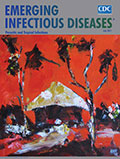
Hantavirus pulmonary syndrome (HPS) is a severe respiratory illness identified in 1993. Since its identification, the Centers for Disease Control and Prevention has obtained standardized information about and maintained a registry of all laboratory-confirmed HPS cases in the United States. During 1993–2009, a total of 510 HPS cases were identified. Case counts have varied from 11 to 48 per year (case-fatality rate 35%). However, there were no trends suggesting increasing or decreasing case counts or fatality rates. Although cases were reported in 30 states, most cases occurred in the western half of the country; annual case counts varied most in the southwestern United States. Increased hematocrits, leukocyte counts, and creatinine levels were more common in HPS case-patients who died. HPS is a severe disease with a high case-fatality rate, and cases continue to occur. The greatest potential for high annual HPS incidence exists in the southwestern United States.
| EID | MacNeil A, Ksiazek TG, Rollin PE. Hantavirus Pulmonary Syndrome, United States, 1993–2009. Emerg Infect Dis. 2011;17(7):1195-1201. https://doi.org/10.3201/eid1707.101306 |
|---|---|
| AMA | MacNeil A, Ksiazek TG, Rollin PE. Hantavirus Pulmonary Syndrome, United States, 1993–2009. Emerging Infectious Diseases. 2011;17(7):1195-1201. doi:10.3201/eid1707.101306. |
| APA | MacNeil, A., Ksiazek, T. G., & Rollin, P. E. (2011). Hantavirus Pulmonary Syndrome, United States, 1993–2009. Emerging Infectious Diseases, 17(7), 1195-1201. https://doi.org/10.3201/eid1707.101306. |
Gnathostomiasis is a foodborne zoonotic helminthic infection caused by the third-stage larvae of Gnathostoma spp. nematodes. The most severe manifestation involves infection of the central nervous system, neurognathostomiasis. Although gnathostomiasis is endemic to Asia and Latin America, almost all neurognathostomiasis cases are reported from Thailand. Despite high rates of illness and death, neurognathostomiasis has received less attention than the more common cutaneous form of gnathostomiasis, possibly because of the apparent geographic confinement of the neurologic infection to 1 country. Recently, however, the disease has been reported in returned travelers in Europe. We reviewed the English-language literature on neurognathostomiasis and analyzed epidemiology and geographic distribution, mode of central nervous system invasion, pathophysiology, clinical features, neuroimaging data, and treatment options. On the basis of epidemiologic data, clinical signs, neuroimaging, and laboratory findings, we propose diagnostic criteria for neurognathostomiasis.
| EID | Katchanov J, Sawanyawisuth K, Chotmongkol V, Nawa Y. Neurognathostomiasis, a Neglected Parasitosis of the Central Nervous System. Emerg Infect Dis. 2011;17(7):1174-1180. https://doi.org/10.3201/eid1707.101433 |
|---|---|
| AMA | Katchanov J, Sawanyawisuth K, Chotmongkol V, et al. Neurognathostomiasis, a Neglected Parasitosis of the Central Nervous System. Emerging Infectious Diseases. 2011;17(7):1174-1180. doi:10.3201/eid1707.101433. |
| APA | Katchanov, J., Sawanyawisuth, K., Chotmongkol, V., & Nawa, Y. (2011). Neurognathostomiasis, a Neglected Parasitosis of the Central Nervous System. Emerging Infectious Diseases, 17(7), 1174-1180. https://doi.org/10.3201/eid1707.101433. |
Volume 17, Number 6—June 2011
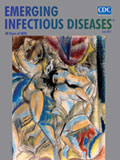
Neurocysticercosis (NCC) is a parasitic infection of the central nervous system caused by Taenia solium larval cysts. Its epidemiology in cysticercosis-nonendemic regions is poorly understood, and the role of public health institutions is unclear. To determine the incidence of NCC and to pilot screening of household contacts for tapeworms, we conducted population-based active surveillance in Oregon. We screened for T. solium infection by examining hospital billing codes and medical charts for NCC diagnosed during January 1, 2006–December 31, 2009 and collecting fecal and blood samples from household contacts of recent case-patients. We identified 87 case-patients, for an annual incidence of 0.5 cases per 100,000 general population and 5.8 cases per 100,000 Hispanics. In 22 households, we confirmed 2 additional NCC case-patients but no current adult intestinal tapeworm infections. NCC is of clinical and public health concern in Oregon, particularly among Hispanics. Public health intervention should focus on family members because household investigations can identify additional case-patients.
| EID | O’Neal SE, Noh J, Wilkins PP, Keene W, Lambert W, Anderson J, et al. Taenia solium Tapeworm Infection, Oregon, 2006–2009. Emerg Infect Dis. 2011;17(6):1030-1036. https://doi.org/10.3201/eid1706.101397 |
|---|---|
| AMA | O’Neal SE, Noh J, Wilkins PP, et al. Taenia solium Tapeworm Infection, Oregon, 2006–2009. Emerging Infectious Diseases. 2011;17(6):1030-1036. doi:10.3201/eid1706.101397. |
| APA | O’Neal, S. E., Noh, J., Wilkins, P. P., Keene, W., Lambert, W., Anderson, J....Townes, J. M. (2011). Taenia solium Tapeworm Infection, Oregon, 2006–2009. Emerging Infectious Diseases, 17(6), 1030-1036. https://doi.org/10.3201/eid1706.101397. |
Resistance to extended-spectrum cephalosporins complicates treatment of Pseudomonas aeruginosa infections. To elucidate risk factors for cefepime-resistant P. aeruginosa and determine its association with patient death, we conducted a case–control study in Philadelphia, Pennsylvania. Among 2,529 patients hospitalized during 2001–2006, a total of 213 (8.4%) had cefepime-resistant P. aeruginosa infection. Independent risk factors were prior use of an extended-spectrum cephalosphorin (p<0.001), prior use of an extended-spectrum penicillin (p = 0.005), prior use of a quinolone (p<0.001), and transfer from an outside facility (p = 0.01). Among those hospitalized at least 30 days, mortality rates were higher for those with cefepime-resistant than with cefepime-susceptible P. aeruginosa infection (20.2% vs. 13.2%, p = 0.007). Cefepime-resistant P. aeruginosa was an independent risk factor for death only for patients for whom it could be isolated from blood (p = 0.001). Strategies to counter its emergence should focus on optimizing use of antipseudomonal drugs.
1Current affiliation: Duke University School of Medicine, Durham, North Carolina, USA.
| EID | Akhabue E, Synnestvedt M, Weiner MG, Bilker WB, Lautenbach E. Cefepime-Resistant Pseudomonas aeruginosa. Emerg Infect Dis. 2011;17(6):1037-1043. https://doi.org/10.3201/eid1706.100358 |
|---|---|
| AMA | Akhabue E, Synnestvedt M, Weiner MG, et al. Cefepime-Resistant Pseudomonas aeruginosa. Emerging Infectious Diseases. 2011;17(6):1037-1043. doi:10.3201/eid1706.100358. |
| APA | Akhabue, E., Synnestvedt, M., Weiner, M. G., Bilker, W. B., & Lautenbach, E. (2011). Cefepime-Resistant Pseudomonas aeruginosa. Emerging Infectious Diseases, 17(6), 1037-1043. https://doi.org/10.3201/eid1706.100358. |
Volume 17, Number 5—May 2011
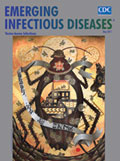
Pneumonic plague is a highly transmissible infectious disease for which fatality rates can be high if untreated; it is considered extremely lethal. Without prompt diagnosis and treatment, disease management can be problematic. In the Democratic Republic of the Congo, 2 outbreaks of pneumonic plague occurred during 2005 and 2006. In 2005, because of limitations in laboratory capabilities, etiology was confirmed only through retrospective serologic studies. This prompted modifications in diagnostic strategies, resulting in isolation of Yersinia pestis during the second outbreak. Results from these outbreaks demonstrate the utility of a rapid diagnostic test detecting F1 antigen for initial diagnosis and public health management, as well as the need for specialized sampling kits and trained personnel for quality specimen collection and appropriate specimen handling and preservation for plague confirmation and Y. pestis isolation. Efficient frontline management and a streamlined diagnostic strategy are essential for confirming plague, especially in remote areas.
| EID | Bertherat E, Thullier P, Shako JC, England K, Koné M, Arntzen L, et al. Lessons Learned about Pneumonic Plague Diagnosis from 2 Outbreaks, Democratic Republic of the Congo. Emerg Infect Dis. 2011;17(5):778-784. https://doi.org/10.3201/eid1705.100029 |
|---|---|
| AMA | Bertherat E, Thullier P, Shako JC, et al. Lessons Learned about Pneumonic Plague Diagnosis from 2 Outbreaks, Democratic Republic of the Congo. Emerging Infectious Diseases. 2011;17(5):778-784. doi:10.3201/eid1705.100029. |
| APA | Bertherat, E., Thullier, P., Shako, J. C., England, K., Koné, M., Arntzen, L....Rahalison, L. (2011). Lessons Learned about Pneumonic Plague Diagnosis from 2 Outbreaks, Democratic Republic of the Congo. Emerging Infectious Diseases, 17(5), 778-784. https://doi.org/10.3201/eid1705.100029. |
Little is known about severe imported Plasmodium falciparum malaria in industrialized countries where the disease is not endemic because most studies have been case reports or have included <200 patients. To identify factors independently associated with the severity of P. falciparum, we conducted a retrospective study using surveillance data obtained from 21,888 P. falciparum patients in France during 1996–2003; 832 were classified as having severe malaria. The global case-fatality rate was 0.4% and the rate of severe malaria was ≈3.8%. Factors independently associated with severe imported P. falciparum malaria were older age, European origin, travel to eastern Africa, absence of chemoprophylaxis, initial visit to a general practitioner, time to diagnosis of 4 to 12 days, and diagnosis during the fall–winter season. Pretravel advice should take into account these factors and promote the use of antimalarial chemoprophylaxis for every traveler, with a particular focus on nonimmune travelers and elderly persons.
| EID | Seringe E, Thellier M, Fontanet A, Legros F, Bouchaud O, Ancelle T, et al. Severe Imported Plasmodium falciparum Malaria, France, 1996–2003. Emerg Infect Dis. 2011;17(5):807-813. https://doi.org/10.3201/eid1705.101527 |
|---|---|
| AMA | Seringe E, Thellier M, Fontanet A, et al. Severe Imported Plasmodium falciparum Malaria, France, 1996–2003. Emerging Infectious Diseases. 2011;17(5):807-813. doi:10.3201/eid1705.101527. |
| APA | Seringe, E., Thellier, M., Fontanet, A., Legros, F., Bouchaud, O., Ancelle, T....Durand, R. (2011). Severe Imported Plasmodium falciparum Malaria, France, 1996–2003. Emerging Infectious Diseases, 17(5), 807-813. https://doi.org/10.3201/eid1705.101527. |
Volume 17, Number 4—April 2011
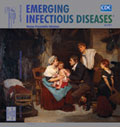
Most oseltamivir-resistant pandemic (H1N1) 2009 viruses have been isolated from immunocompromised patients. To describe the clinical features, treatment, outcomes, and virologic data associated with infection from pandemic (H1N1) 2009 virus with H275Y mutation in immunocompromised patients, we retrospectively identified 49 hematology–oncology patients infected with pandemic (H1N1) 2009 virus. Samples from 33 of those patients were tested for H275Y genotype by allele-specific real-time PCR. Of the 8 patients in whom H275Y mutations was identified, 1 had severe pneumonia; 3 had mild pneumonia with prolonged virus shedding; and 4 had upper respiratory tract infection, of whom 3 had prolonged virus shedding. All patients had received oseltamivir before the H275Y mutation was detected; 1 had received antiviral prophylaxis. Three patients excreted resistant virus for >60 days. Emergence of oseltamivir resistance is frequent in immunocompromised patients infected with pandemic (H1N1) 2009 virus and can be associated with a wide range of clinical disease and viral kinetics.
| EID | Renaud C, Boudreault AA, Kuypers J, Lofy KH, Corey L, Boeckh MJ, et al. H275Y Mutant Pandemic (H1N1) 2009 Virus in Immunocompromised Patients. Emerg Infect Dis. 2011;17(4):653-660. https://doi.org/10.3201/eid1704.101429 |
|---|---|
| AMA | Renaud C, Boudreault AA, Kuypers J, et al. H275Y Mutant Pandemic (H1N1) 2009 Virus in Immunocompromised Patients. Emerging Infectious Diseases. 2011;17(4):653-660. doi:10.3201/eid1704.101429. |
| APA | Renaud, C., Boudreault, A. A., Kuypers, J., Lofy, K. H., Corey, L., Boeckh, M. J....Englund, J. A. (2011). H275Y Mutant Pandemic (H1N1) 2009 Virus in Immunocompromised Patients. Emerging Infectious Diseases, 17(4), 653-660. https://doi.org/10.3201/eid1704.101429. |
We analyzed data from hospital admissions and enhanced mumps surveillance to assess mumps complications during the largest mumps outbreak in England and Wales, 2004–2005, and their association with mumps vaccination. When compared with nonoutbreak periods, the outbreak was associated with a clear increase in hospitalized patients with orchitis, meningitis, and pancreatitis. Routine mumps surveillance and hospital data showed that 6.1% of estimated mumps patients were hospitalized, 4.4% had orchitis, 0.35% meningitis, and 0.33% pancreatitis. Enhanced surveillance data showed 2.9% of mumps patients were hospitalized, 6.1% had orchitis, 0.3% had meningitis, and 0.25% had pancreatitis. Risk was reduced for hospitalization (odds ratio [OR] 0.54, 95% confidence interval [CI] 0.43–0.68), mumps orchitis (OR 0.72, 95% CI 0.56–0.93) and mumps meningitis (OR 0.28, 95% CI 0.14–0.56) when patient had received 1 dose of measles, mumps, and rubella vaccine. The protective effect of vaccination on disease severity is critical in assessing the total effects of current and future mumps control strategies.
| EID | Yung C, Andrews N, Bukasa A, Brown KE, Ramsay M. Mumps Complications and Effects of Mumps Vaccination, England and Wales, 2002–2006. Emerg Infect Dis. 2011;17(4):661-667. https://doi.org/10.3201/eid1704.101461 |
|---|---|
| AMA | Yung C, Andrews N, Bukasa A, et al. Mumps Complications and Effects of Mumps Vaccination, England and Wales, 2002–2006. Emerging Infectious Diseases. 2011;17(4):661-667. doi:10.3201/eid1704.101461. |
| APA | Yung, C., Andrews, N., Bukasa, A., Brown, K. E., & Ramsay, M. (2011). Mumps Complications and Effects of Mumps Vaccination, England and Wales, 2002–2006. Emerging Infectious Diseases, 17(4), 661-667. https://doi.org/10.3201/eid1704.101461. |
Volume 17, Number 3—March 2011
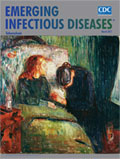
Trends in Staphylococcus aureus infections are not well described. To calculate incidence in overall S. aureus infection and invasive and noninvasive infections according to methicillin susceptibility and location, we conducted a 10-year population-based retrospective cohort study (1999–2008) using patient-level data in the Veterans Affairs Maryland Health Care System. We found 3,674 S. aureus infections: 2,816 (77%) were noninvasive; 2,256 (61%) were methicillin-resistant S. aureus (MRSA); 2,517 (69%) were community onset, and 1,157 (31%) were hospital onset. Sixty-one percent of noninvasive infections were skin and soft tissue infections; 1,112 (65%) of these were MRSA. Ten-year averaged incidence per 100,000 veterans was 749 (± 132 SD, range 549–954) overall, 178 (± 41 SD, range 114–259) invasive, and 571 (± 152 SD, range 364–801) noninvasive S. aureus infections. Incidence of all S. aureus infections significantly increased (p<0.001), driven by noninvasive, MRSA, and community-onset infections (p<0.001); incidence of invasive S. aureus infection significantly decreased (p<0.001).
| EID | Tracy LA, Furuno JP, Harris AD, Singer M, Langenberg P, Roghmann M. Staphylococcus aureus Infections in US Veterans, Maryland, USA, 1999–2008. Emerg Infect Dis. 2011;17(3):441-448. https://doi.org/10.3201/eid1703.100502 |
|---|---|
| AMA | Tracy LA, Furuno JP, Harris AD, et al. Staphylococcus aureus Infections in US Veterans, Maryland, USA, 1999–2008. Emerging Infectious Diseases. 2011;17(3):441-448. doi:10.3201/eid1703.100502. |
| APA | Tracy, L. A., Furuno, J. P., Harris, A. D., Singer, M., Langenberg, P., & Roghmann, M. (2011). Staphylococcus aureus Infections in US Veterans, Maryland, USA, 1999–2008. Emerging Infectious Diseases, 17(3), 441-448. https://doi.org/10.3201/eid1703.100502. |
To assess the annual risk for latent tuberculosis infection (LTBI) among health care workers (HCWs), the incidence rate ratio for tuberculosis (TB) among HCWs worldwide, and the population-attributable fraction of TB to exposure of HCWs in their work settings, we reviewed the literature. Stratified pooled estimates for the LTBI rate for countries with low (<50 cases/100,000 population), intermediate (50–100/100,000 population), and high (>100/100,000 population) TB incidence were 3.8% (95% confidence interval [CI] 3.0%–4.6%), 6.9% (95% CI 3.4%–10.3%), and 8.4% (95% CI 2.7%–14.0%), respectively. For TB, estimated incident rate ratios were 2.4 (95% CI 1.2–3.6), 2.4 (95% CI 1.0–3.8), and 3.7 (95% CI 2.9–4.5), respectively. Median estimated population-attributable fraction for TB was as high as 0.4%. HCWs are at higher than average risk for TB. Sound TB infection control measures should be implemented in all health care facilities with patients suspected of having infectious TB.
| EID | Baussano I, Nunn P, Williams B, Pivetta E, Bugiani M, Scano F. Tuberculosis among Health Care Workers. Emerg Infect Dis. 2011;17(3):488-494. https://doi.org/10.3201/eid1703.100947 |
|---|---|
| AMA | Baussano I, Nunn P, Williams B, et al. Tuberculosis among Health Care Workers. Emerging Infectious Diseases. 2011;17(3):488-494. doi:10.3201/eid1703.100947. |
| APA | Baussano, I., Nunn, P., Williams, B., Pivetta, E., Bugiani, M., & Scano, F. (2011). Tuberculosis among Health Care Workers. Emerging Infectious Diseases, 17(3), 488-494. https://doi.org/10.3201/eid1703.100947. |
Volume 17, Number 2—February 2011

Information about the spectrum of disease caused by hepatitis E virus (HEV) genotype 3 is emerging. During 2004–2009, at 2 hospitals in the United Kingdom and France, among 126 patients with locally acquired acute and chronic HEV genotype 3 infection, neurologic complications developed in 7 (5.5%): inflammatory polyradiculopathy (n = 3), Guillain-Barré syndrome (n = 1), bilateral brachial neuritis (n = 1), encephalitis (n = 1), and ataxia/proximal myopathy (n = 1). Three cases occurred in nonimmunocompromised patients with acute HEV infection, and 4 were in immunocompromised patients with chronic HEV infection. HEV RNA was detected in cerebrospinal fluid of all 4 patients with chronic HEV infection but not in that of 2 patients with acute HEV infection. Neurologic outcomes were complete resolution (n = 3), improvement with residual neurologic deficit (n = 3), and no improvement (n = 1). Neurologic disorders are an emerging extrahepatic manifestation of HEV infection.
| EID | Kamar N, Bendall RP, Peron JM, Cintas P, Prudhomme L, Mansuy J, et al. Hepatitis E Virus and Neurologic Disorders. Emerg Infect Dis. 2011;17(2):173-179. https://doi.org/10.3201/eid1702.100856 |
|---|---|
| AMA | Kamar N, Bendall RP, Peron JM, et al. Hepatitis E Virus and Neurologic Disorders. Emerging Infectious Diseases. 2011;17(2):173-179. doi:10.3201/eid1702.100856. |
| APA | Kamar, N., Bendall, R. P., Peron, J. M., Cintas, P., Prudhomme, L., Mansuy, J....Dalton, H. R. (2011). Hepatitis E Virus and Neurologic Disorders. Emerging Infectious Diseases, 17(2), 173-179. https://doi.org/10.3201/eid1702.100856. |
In most industrialized countries, pets are becoming an integral part of households, sharing human lifestyles, bedrooms, and beds. The estimated percentage of pet owners who allow dogs and cats on their beds is 14%–62%. However, public health risks, including increased emergence of zoonoses, may be associated with such practices.
| EID | Chomel BB, Sun B. Zoonoses in the Bedroom. Emerg Infect Dis. 2011;17(2):167-172. https://doi.org/10.3201/eid1702.101070 |
|---|---|
| AMA | Chomel BB, Sun B. Zoonoses in the Bedroom. Emerging Infectious Diseases. 2011;17(2):167-172. doi:10.3201/eid1702.101070. |
| APA | Chomel, B. B., & Sun, B. (2011). Zoonoses in the Bedroom. Emerging Infectious Diseases, 17(2), 167-172. https://doi.org/10.3201/eid1702.101070. |
Volume 17, Number 1—January 2011
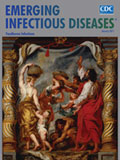
Cysticercosis has emerged as a cause of severe neurologic disease in the United States that primarily affects immigrants from Latin America. Moreover, the relevance of cysticercosis as a public health problem has been highlighted by local transmission. We searched the biomedical literature for reports documenting cases of cysticercosis acquired in the United States. A total of 78 cases, principally neurocysticercosis, were reported from 12 states during 1954–2005. A confirmed or presumptive source of infection was identified among household members or close personal contacts of 16 (21%) case-patients. Several factors, including the severe, potentially fatal, nature of cysticercosis; its fecal–oral route of transmission; the considerable economic effect; the availability of a sensitive and specific serologic test for infection by adult Taenia solium tapeworms; and the demonstrated ability to find a probable source of infection among contacts, all provide a compelling rationale for implementation of public health control efforts.
| EID | Sorvillo FJ, Wilkins PP, Shafir S, Eberhard ML. Public Health Implications of Cysticercosis Acquired in the United States. Emerg Infect Dis. 2011;17(1):1-6. https://doi.org/10.3201/eid1701.101210 |
|---|---|
| AMA | Sorvillo FJ, Wilkins PP, Shafir S, et al. Public Health Implications of Cysticercosis Acquired in the United States. Emerging Infectious Diseases. 2011;17(1):1-6. doi:10.3201/eid1701.101210. |
| APA | Sorvillo, F. J., Wilkins, P. P., Shafir, S., & Eberhard, M. L. (2011). Public Health Implications of Cysticercosis Acquired in the United States. Emerging Infectious Diseases, 17(1), 1-6. https://doi.org/10.3201/eid1701.101210. |
Infections with hepatitis E virus (HEV) in solid-organ transplant recipients can lead to chronic hepatitis. However, the incidence of de novo HEV infections after transplantation and risk for reactivation in patients with antibodies against HEV before transplantation are unknown. Pretransplant prevalence of these antibodies in 700 solid-organ transplant recipients at Toulouse University Hospital in France was 14.1%. We found no HEV reactivation among patients with antibodies against HEV at the first annual checkup or by measuring liver enzyme activities and HEV RNA. In contrast, we found 34 locally acquired HEV infections among patients with no antibodies against HEV, 47% of whom had a chronic infection, resulting in an incidence of 3.2/100 person-years. Independent risk factors for HEV infection were an age <52 years at transplantation and receiving a liver transplant. Effective prophylactic measures that include those for potential zoonotic infections should reduce the risk for HEV transmission in this population.
| EID | Legrand-Abravanel F, Kamar N, Sandres-Saune K, Lhomme S, Mansuy J, Muscari F, et al. Hepatitis E Virus Infection without Reactivation in Solid-Organ Transplant Recipients, France. Emerg Infect Dis. 2011;17(1):30-37. https://doi.org/10.3201/eid1701.100527 |
|---|---|
| AMA | Legrand-Abravanel F, Kamar N, Sandres-Saune K, et al. Hepatitis E Virus Infection without Reactivation in Solid-Organ Transplant Recipients, France. Emerging Infectious Diseases. 2011;17(1):30-37. doi:10.3201/eid1701.100527. |
| APA | Legrand-Abravanel, F., Kamar, N., Sandres-Saune, K., Lhomme, S., Mansuy, J., Muscari, F....Izopet, J. (2011). Hepatitis E Virus Infection without Reactivation in Solid-Organ Transplant Recipients, France. Emerging Infectious Diseases, 17(1), 30-37. https://doi.org/10.3201/eid1701.100527. |
CME Articles by Volume




